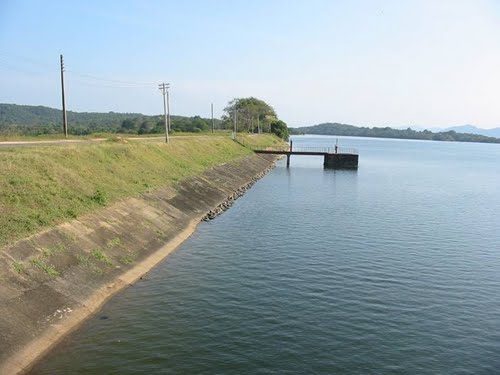 |
Home About Directory Conservation |
 |
Minneriya Reservoir Location: 80 5’ 0 N and 800 51’ 7 E to 70 57’ 0 N and 800 57’ 0 E; 893514 N and 483473 N and 878771 N and 494489 E; approximately 20km northwest of Polonnaruwa in the Polonnaruwa District, of the North-central Province. Area: 2,550 ha. Altitude: c. 100m Overview: The Minneriya reservoir is a man-made, non-tidal water retention reservoir, built primarily for irrigation purposes. The reservoir falls within the the Mahaweli River Basin, and is of historical importance, having been built in the third century AD with a catchment area of 24,000 ha. The reservoir and surrounding areas have been declared a National Park. Birdlife International has identified Minneriya as an IBA due to its populations of globally threatened bird species. Physical features: The reservoir has a maximum depth of 10.7m, and the average pH of the water is 7.5. The conductivity value of this reservoir suggests that it is relatively nutrient poor, and this is probably due to the high flushing rate resulting from the feeding of two major down-stream reservoirs (Kantale and Kaudulla), as well as demand for irrigation water supply. The main source of water for the reservoir is from a diversion of the Amban Ganga, along the Elahara Channel. The Minneriya reservoir is located in the dry zone and experiences an average rainfall of 1,500-2,000mm. The wet season is during the northeast monsoon between October and January, while the May to August period is considered the dry season. Ecological features: The Minneriya Reservoir is located within Minneriya National Park (8,889 ha). The park comprises lowforested hills that feed the third century reservoir and more recent Giritale reservoir. The vegetation in the area is composed of dry zone forest, scrublands and grasslands. During the dry season, grass along the reservoir edges attracts large numbers of elephants. The reservoir itself is an important water source for large herds of elephants that frequent the park and surrounding forest areas. It is also an important habitat for numerous water birds. Noteworthy fauna: The freshwater fish are dominated by exotic forms (i.e. Oreochromis spp., Tilapia rendali, Ctenopharyngodon idella, Labeo rohita, Aristichthys nobilis, Osphronemus goramy). Aquatic reptiles in the tank include Lissemys punctata and Crocodylus palustris. Large water birds include Leptoptilos javanicus, Mycteria leucocephala and Pelecanus philippensis. The tank contributes to the sustainance of a large herd of Elephas maximus in the park. Noteworthy flora: The surrounding habitat is dominated by Terminalia arjuna, Manilkara hexandra, Azadirachta indica, Ficus religiosa and Bauhinia racemosa. Land use: Small-scale fisheries are carried out within the reservoir. The wetland areas and surrounding grasslands and forests are also used for livestock grazing, timber collection and chena cultivation. Paddy cultivation is also carried out in the vicinity and is aided by irrigation water from the reservoir, while sedimented clays found in the area are used for manufacturing bricks. Possible changes in land use: Conversion of land for paddy and chena cultivation is possible due to increased demand for agricultural land. Encroachment of National Park by home gardens, houses and shops is also possible, along with an increase in fishing effort. Hydrological and biophysical values: The most important hydrological factor of the reservoir, which influences both fisheries productivity and wildlife conservation, is the pattern of change in reservoir water levels. Additionally, it provides a source of water to the surrounding paddy fields. Social and cultural values: This reservoir is of historical importance as it was originally constructed by King Mahasen in the third century AD. The Irrigation Department has constructed a shrine room onsite to honour the work of this historically important King. Scientific research and monitoring: The reservoir and surrounding areas have been studied by several universities. The ADB funded PAM project carried out by the DWC is also conducting several studies. Minneriya National Park also functions as the DWC training centre. Conservation education: There is a visitor centre at the entrance of the National Park, which provides educational information, and awareness programmes are being conducted under the PAM project. Recreation and tourism: The National Park is a huge visitor attraction mostly because of the large elephant herd that visits the reservoir all year round but more so during the dry season. Conservation measures taken: In 1993, the CEA produced a wetland site report and conservation management plan for the reservoir. Minneriya reservoir is located within the Minneriya National Park, which was first accorded protected status as a Sanctuary in 1938, and subsequently upgraded to a National Park in 1997 under the FFPO. It is also part of the Minneriya-Giritale Nature Reserve, which was declared in 4 blocks between 1988 and 1997. Currently, the Forest Department is conducting some reforestation projects in the area. Conservation measures proposed: The conservation management plan produced by the CEA proposes a number of conservation measures, which include habitat restoration, removal of livestock from the park area and development of tourism facilities. Disturbance and threats: The main threat to the reservoir area is the clearing of vegetation for firewood, which causes environmental imbalance and can eventually result in lowering of the water table and soil erosion in the catchment area. Pollution in densely populated bathing areas, encroachment and illegal agricultural activities, overfishing, and poaching are additional anthropogenic threats. The invasive species Lantana camara appears to be spreading throughout the park Land tenure: State owned Management authority and jurisdication: DWC References: BirdLife International (2005); CEA/ARCADIS Euroconsult (1993b); Petr (1985); Somasunderam (2003); |
| Maps |